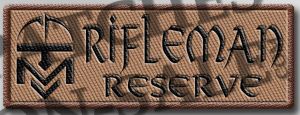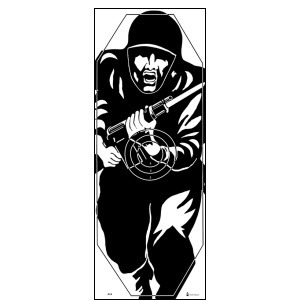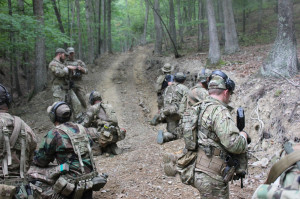Update: MVT Rifleman Challenge
NEW PAGE HERE. Details:
MVT RIFLEMAN CHALLENGE
Outline: MVT will offer ‘MVT Rifleman Challenge‘ three day weekends where a series of light infantry skills will be tested. Successful completion of these tests will result in the award of an ‘MVT RIFLEMAN’ patch. The first weekend will be scheduled for the spring of 2015, exact date TBD.
Intent: To foster excellence among the community of armed civilians, in order to raise training standards and provide a readily identifiable, achievable, skill level.
Scope: Three day MVT Rifleman Challenge weekends will be scheduled, during which a number of the required Rifleman skills will be tested. MVT Rifleman patches will be awarded to all who meet the standards. A number of the individual skills will be tested in a pass/fail manner. A number of other skills will be tested on a random and team basis, in order to ensure that the individual students have mastered the Rifleman tasks. For some topics there will be instructional periods followed by testing.
Two Rifleman Patches will be awarded on completion of all tasks successfully, depending on performance on the PT test:
MVT Rifleman:
MVT Rifleman Reserve:
Note: these images are snipped from proofs on order.
CORE RIFLEMAN TASKS TESTED:
There will be 8 test events. These events will consist of individual and team challenges. Tasks will be assessed both objectively and subjectively: individual events will be assessed for time and successful task completion; team events will be assessed for successful task completion, teamwork and effort.
8 STANDARD TEST EVENTS:
- PT Test: ‘2-Miler’
- Combat Shooting qualification: rifle & handgun
- Weapon Manipulation
- Navigation
- Team Casualty Evacuation
- Move Under Direct Fire
- Break Contact Under Direct Fire
- Conduct Tactical Combat Casualty Care
Detail on Standard Test Events:
MOVE:
PT Test: ‘2 miler’:’
30 lb ruck, rifle. MVT 2 mile course run as an individual. The MVT course is hilly and more challenging than a standard 2-miler route:
Goal: Sub 22 minutes:
Rifleman Pass: Sub 25 minutes
Rifleman Reserve Pass: Sub 30 minutes
The 2-Miler is an individual best effort event, designed to simulate a rapid movement to relieve troops in contact. It is a physical and mental challenge that will asses an individual’s aptitude for the Rifleman role. It tests physical fitness, heart and determination.
Slings may be used on rifles, but the rifle must not be carried on the back or on/in the ruck. It must be carried either to the front of the body or at the trail.
Note: for training purposes, for the 2-Miler run on a flat or gently rolling course, the goal is sub-18 minutes, sub 20 minutes for Rifleman, sub 25 minutes for Rifleman Reserve.
Navigate: MVT navigation course: use a map and compass, navigate point to point across country as an individual. Load Bearing Equipment (LBE) and rifle.
Team Casualty Evacuation: team casualty evacuation. Physical event.
SHOOT:
Combat Shooting Qualification: The shoot takes place with a short break after the 2-Miler. Time will be given to walk from the end of the course to the range, drop ruck, drink water and put on LBE. This is designed to simulate combat and the stress of engaging the enemy after the 2-Mile approach.
Pass marksmanship standards on rifle and handgun:
Course of Fire:
5 x 10 round magazines rifle, 1 x 10 round magazine handgun.
Short run onto the 50 yard firing point:
10 rounds kneeling
10 rounds prone
40 seconds including magazine changes.
Advance to 25 yards on command:
10 rounds standing
10 rounds kneeling
40 seconds including magazine changes.
Advance on command:
Ready up standing controlled pairs x 5 on command from 25 to 10 yards.
10 yards: transition to handgun, 10 rounds 15 seconds.
Total rounds 60 (rifle 50, handgun 10), max score 300, current pass mark 225. To be beta tested further and adjusted if necessary.
Below: Example Ivan Qualification Target. It will either be this fig. 11 or the fig. 12.
Weapon Manipulation: Perform speed reload, tactical reload, and malfunction/stoppage drills on rifle and handgun: tested to standard.
FIGHT:
Move under direct fire: fire and movement: Conduct live fire buddy pair or team fire and movement to standard.
Perform unit SOP break contact/anti-ambush drills: Perform 4 man team live fire break contact drills to standard. Contact front or flank (left/right) will be tested.
Note: there will be scope for rehearsals for these live fire drills.
Conduct tactical combat casualty care (TC3) to combat lifesaver standard. This will take the form of an instructional period followed by trauma lanes for testing.
_____________________________
ADDITIONAL CORE RIFLEMAN TASKS:
The following are skills which are expected to be known for the MVT Rifleman Standard. In some cases, instructional periods will be provided prior to testing. These skills will be tested either at random or as part of training scenarios (wildcards). It is important to note that:
1) Not all of these skills will be tested on the 3 day Challenge weekend, but any of them can be.
2) Some skills, if included, will have a period of instruction provided prior to any testing.
3) The intent of the cadre is to pass people, if they demonstrate the knowledge to a reasonable degree, and if any knowledge or skill gaps can be made good with a short period of instruction.
4) Rehearsals will be conducted for team movement tasks, and it is not the intent of the cadre to catch people out. The intent is to develop and train.
SHOOT:
Load, unload, strip and reassemble, clean and maintain personal weapons, including field cleaning.
Prepare a range card.
MOVE:
Conduct squad and team movement techniques and formations.
Basic fieldcraft: camouflage and concealment, movement under enemy observation.
Conduct a team or squad level patrol.
Actions on/SOPs:
Linear Danger Areas: conduct team or squad LDA crossing drills.
Action on Objective: Close Target Recce, Observation Post.
Lights/flares.
Halts: conduct security halt formation.
Conduct of a squad hasty ambush.
Avoid thermal surveillance utilizing terrain and vegetation masking.
COMMUNICATE:
Perform voice communications including reports, voice procedure, phonetic alphabet: TBD.
Perform visual signaling. Hand signals: TBD.
FIGHT:
Enter and clear a room.
Conduct a simple squad deliberate ambush (L-shaped or Linear).
Conduct support by fire for a squad attack.
Conduct an assault as part of a squad attack.
Occupy a squad patrol base.
Establish a buddy pair shelter area.
Theory of cover: identify temporary fighting positions.
React to indirect fire.
Duties of a sentry
Search enemy dead.
Prisoner handling.
Conduct personal administration in the field: maintain combat effectiveness.
Example Outline Weekend Training Schedule
Day 1:
Arrive. Administration.
PT Test
Shooting Qualification
Tactical Combat Casualty Care training and trauma lanes.
Day 2:
Navigation Course
Break Contact under direct fire*
Weapon Manipulation
*Note: some wildcard core skill testing will take place as background activity during wait times.
Day 3:
Casualty Evacuation
Random Skill Testing – Wildcards
Awards
Depart
Note: attendance on MVT Progression training classes, including Combat Team Tactics and Combat Patrol, will train the majority of skills on this list.
The MVT Rifleman Challenge is intended to form the first rung of a training progression. MVT will construct leadership classes in order to award patches for successful completion. The next level patch will be MVT Squad Leader . That class will teach SUT, leadership and troop leading procedures.




